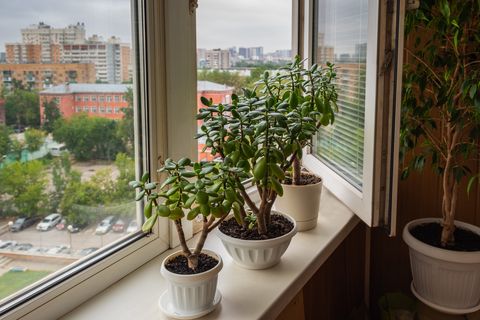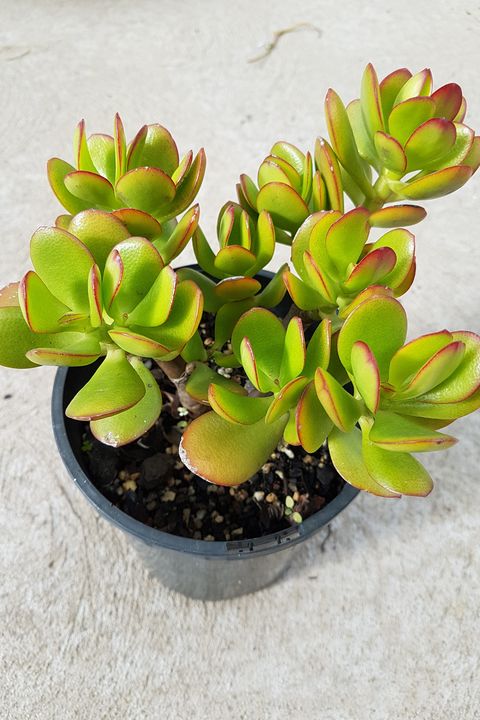Native to South Africa, the jade plant is popular for its tree-like appearance. Its smooth, oval-shaped leaves and strong, woody stems are a symbol of friendship, luck and prosperity — making the jade plant one of the best Feng Shui houseplants for good energy.
If you’re wondering where to place the jade plant in your home, they do best in bright indoor spaces — like a south- or west-facing window. Depending on its size, go for a raised planter in a bright corner or a small pot in the windowsill. Jade plants also grow well outside, as long as you take them inside during cold fall and winter months. With proper care, this resilient houseplant can live for more than 50 years.
Jade plants, also known as crassula ovata, are found in many varieties with slightly different characteristics: crassula ovata “Gollum” has red-tinted and tubular leaves, crassula ovata “Hummel’s Sunset” has leaves with red and yellow edges, crassula ovata “Pink Beauty” has clusters of star-shaped pink flowers. But, don’t worry: you can care for all jade plants in the same way. Keep scrolling to learn how to keep this sun-loving succulent healthy — plus, how to grow even more jade plants.
⚠️ Warning: The jade plant is mildly toxic to humans when consumed, and extremely poisonous to dogs and cats.
Jade Plant Care Tips
Sunlight
Keep your jade plant in bright light for at least six hours per day, according to Almanac. While mature plants can handle direct sunlight, younger plants require a bright space that’s free of direct rays. Without proper sunlight, your jade plant will stop growing, or it’ll grow tall and leggy.
Temperature
Jade plants do best at room temperature, between 65 and 75 degrees Fahrenheit, during the day. They prefer a cooler temperature at night, between 50 and 55 degrees Fahrenheit. During the winter months, it’s important to keep your plant away from cool drafts or icy windows. Note, if you keep your jade plant outside, it should be kept inside when outside temperatures drop.
Watering
You should only water your jade plant once the soil is completely dry, according to Gardener Report. Check the soil around the roots to be sure. Your jade plant will need a generous soak about every 14 days, although the frequency in which you have to water your plant will depend on the season. Jade plants need more water in the summer and much less in the winter.
Take note: More often than not, jade plants die because of improper watering.
Fertilizing
Use a standard liquid fertilizer at half strength every several weeks during the growing season (hint: that means spring or summer). The best fertilizers for jade plants have a 10-20-10 ratio. The soil should be moist before applying fertilizer to avoid damaging the roots.
Soil
Your jade plant needs well-draining soil. According to Petal Republic, the best combination is a 2:2:1 blend of cactus potting mix, coarse sand and perlite or pumice. To save yourself time, you can find a soil that’s been specifically blended for jade plants.
Repotting
Young jade plants should be repotted every two or three years, while adult plants should be repotted every four to five years in the early spring. Keep in mind: If you like the size of your plant, jade plants don’t mind being root bound.
Common Problems With Jade Plants to Avoid
- Yellow Leaves: The primary cause of yellow leaves is overwatering or poor drainage. Keep in mind that jade plants don’t like being too wet. Be sure your planter has drainage holes, and you’re emptying excess water from the saucer.
- Root rot: Be careful not to overwater your jade plant, as they are susceptible to root rot. If you notice soggy soil or soft, squishy leaves (a telltale sign of overwatering), you should repot your jade plant immediately.
- Shriveled Leaves: This could be a sign of both overwatering and under-watering, but wrinkly and shriveled leaves are likely the result of too little water. If the soil is dried out completely, give your plant a good watering and the leaves should bounce back to health.
- Leaf drop: Overwatering or poor drainage can result in a loss of leaves. Any sort of stress to your plant, including a lack of sunlight or a sudden drop in temperature, can also be the cause.
- Pests: You may be dealing with mealybugs (the most likely culprit), root mealybugs, spider mites, scale or aphids. Depending on the insect, you can treat your plant with insecticidal soaps or Neem oil; you may also have to remove the little pests by hand, according to Petal Republic.
How to Propagate Your Jade Plant
If you’ve never propagated a plant before, the jade plant is a great place to start. There are two simple ways to grow a new plant: either from a cutting or a single leaf. To use a cutting, start with a cut that’s at least three inches long and allow the cutting to dry out for a few days in a warm, dry place. Place the cutting into a potting mixture and water sparingly (the soil should only be damp).
If you’d rather use a single leaf, or there isn’t a healthy cutting available, you can start by laying healthy leaves onto your potting mixture. As you water the leaves sparingly, they will start to grow roots and, soon enough, tiny plants. Once there are visible plantlets, you’re ready to pot your new plant.
This content is created and maintained by a third party, and imported onto this page to help users provide their email addresses. You may be able to find more information about this and similar content at piano.io


